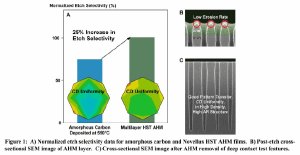Nov 24 2009
Novellus Systems (NASDAQ:NVLS) has developed a suite of ashable hardmask (AHM) films that have up to 25 percent greater etch selectivity compared to similar amorphous carbon films in use by the industry today. This highly selective and transparent (HST) AHM family of films has demonstrated die yield improvements as much as 7 percent when coupled with Novellus' patented integrated edge bevel removal (EBR) technology.

Sub-32nm device design rules require high aspect ratio (AR) patterning for both logic and memory devices. At these advanced geometries, plasma-enhanced chemical vapor deposition (PECVD) based amorphous carbon films have higher etch selectivities and superior mechanical properties than traditional photoresists. Additionally, films of this nature enable more accurate pattern transfer from the photoresist to the substrate without complications such as pattern collapse and line bending. These amorphous carbon films are also used for double patterning schemes, enabling cost effective, high density patterning.
Figure 1A contrasts the normalized etch selectivity for a conventional amorphous carbon film deposited at 550°C with a Novellus HST AHM film. While increasing deposition temperature can be used to increase selectivity, it also has the negative effect of decreasing the film's transparency. Less transparent films are more difficult to align during the photo step. With Novellus AHM films, transparency is not sacrificed, and the selectivity required for high AR patterning is maintained. Also shown in Figure 1A are critical dimension uniformity (CDU) maps showing typical etch selectivity performance for conventional amorphous carbon films and Novellus HST AHM films. The high selectivity and low erosion rate of the Novellus films demonstrate better within-wafer CDU performance, which facilitates the patterning of dense, high AR features (Figures 1B and 1C) and is critical to yield enhancement.
The AHM thickness at the wafer's edge impacts the die yield in that region, requiring a narrow transition zone from full AHM thickness to bare silicon (i.e., complete AHM removal). Novellus' VECTOR PECVD platform features an integrated EBR capability that provides complete removal of the AHM film within a 1mm transition zone. This sharp transition ensures that edge die have the required AHM thickness necessary for excellent CD uniformity control within 2 mm from the wafer's edge. Because the EBR module is integrated onto the deposition platform, no additional bevel edge cleaning tools are required. And, since the AHM removal is performed outside the deposition chamber, better process and particle control can be achieved as compared to other in-situ edge control techniques.
In addition to enhanced die yield, Novellus' HST AHM films also provide a wider process window in a high volume manufacturing environment. Conventional amorphous carbon films deposited at higher temperatures are prone to moisture absorption at a faster rate. However, the multi-station sequential deposition (MSSD) architecture of the Novellus VECTOR PECVD platform enables superior hermeticity performance by incorporating process interfaces, which help to block moisture uptake.
"Novellus' HST AHM films meet the high density, high aspect ratio patterning requirements necessary for sub-32 nm devices," said Kevin Jennings, senior vice president for Novellus' PECVD business unit. "Coupled with the proven productivity of the VECTOR platform, Novellus' HST AHM solution is the low cost, high volume manufacturing choice for these advanced optical films."